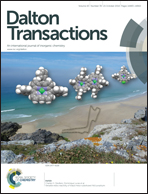Tuning the electronic coupling in Mo2–Mo2 systems by variation of the coordinating atoms of the bridging ligands†
Abstract
Three novel [Mo2]–bridge–[Mo2] complexes were synthesized by a convergent assembling reaction of the dimetal precursor Mo2(DAniF)3(O2CCH3) (DAniF = N,N′-di(p-anisyl)formamidinate) with the bridging ligands terephthalamidine, terephthalamide and dithioterephthalamide. The structures of these compounds, [Mo2(DAniF)3]2[μ-1,4-{C(E)NH}2-C6H4] (E = NH (1), O (2) or S (3)), were determined, either by X-ray crystallography or 1H NMR spectroscopy, to be the analogues of the terephthalate bridged dimolybdenum dimer. These compounds are structurally and electronically closely related by having the same structural skeleton and similar bonding parameters, which allowed us to analyze the differences between N, O and S atoms on the bridging ligand in promoting electronic interaction between the two [Mo2] units. In the electronic spectra, the metal to ligand charge transfer absorption bands, attributed to the HOMO (dδ) → LUMO (pπ*) transition, was red shifted as the variable atoms change from N to O to S. The mixed-valence species 1+, 2+ and 3+, generated by one-electron oxidation of the neutral precursors and measured in situ, exhibited characteristic intervalence absorption bands, for which the energy and half-height bandwidth decreased from 1+ to 3+. Therefore, in comparison to O atoms, S atoms are capable of enhancing the electronic coupling between the two [Mo2] units, and the incorporation of N atoms to the bridging ligands slightly diminished the metal–metal interaction. The molecular structures and spectroscopic properties of these compounds were simulated by theoretical calculations at DFT level on the simplified models, which gave results consistent with the experimental observations.


 Please wait while we load your content...
Please wait while we load your content...